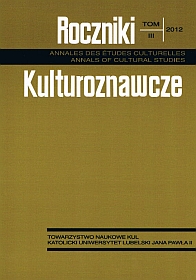“Redemptive Beauty” in the Victorines’ Theory of Aesthetics
Abstract
The authors of the aesthetics in the Victorines’ school are its most famous members: Hugh and his disciple Richard. Hugh was the first one who devoted a substantial part of his work to theory of aesthetics, which he included in the seventh book of the encyclopaedic work Didascalion de studio legendi. He refers there to the Neoplatonic theory of aesthetics following the Dionysian-Eriugenian theory of symbolism. In the first two parts he develops ontological foundations of aesthetics and its psychological determinants. In the ontological aspect Hugh is an objectivist and treats beauty as a constitutive property of beings. In the part concerning psychological foundations of aesthetics he introduces a specific power which combines two aspects of aesthetic experiences — spiritual and sensual. It is the so called affectio imaginaria, incorporated into the theory of psychophysical unity of human being. The issues related to the role of beauty in human life and aesthetic experience as a path leading to mystical life Hugh supplements with ethical considerations. He devotes a large part of his work to discussion of the definition of beauty. The most original part of Hugh’s aesthetics is the one in which he distinguishes formal categories of beauty: placement (situs), motion (motus), quality grasped by sight (species) and qualities experienced by other senses (qualitas). The theory of mystical contemplation of beauty understood as a process of the soul’s climbing to God analogous to Plotinian conception of ‘epistrophe’ can be considered a peculiar crowning of Hugh’s aesthetics.
References
Baron R.: Hugues & Richard de Saint-Victor. Tournai: Bloud & Gay 1961.
Bruyne E. de: Études d’esthétique médiévale. T. 2: L’époque romane. Brugge: De Tempel 1946.
Gilson É.: La Théologie mystique de S. Bernard. Paris: J. Vrin 1934.
Janeczek S.: Hugon ze Świętego Wiktora. W: Powszechna Encyklopedia Filozofii. T. 4. Lublin: PTTA 2003 s. 620-623.
Tatarkiewicz W.: Historia estetyki. T. 2. Warszawa: Wydawnictwo Naukowe PWN 2009.





